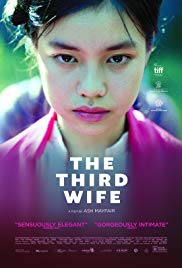
THE THIRD WIFE
Vietnam, 2018, 96 minutes, Colour.
Nguyen Phuong Tra My.
Directed by Ash Mayfair.
The setting is Vietnam at the end of the 19th century.
We are invited into a rather enclosed world and the Vietnamese countryside, a countryside of beautiful scenery and surroundings. We are in a wealthy home, beautiful exteriors and interiors, a family, and many servants scurrying to and fro as well as a farm, farm animals, crops and harvest. There may be an outside world but we stay within the confines of the property.
Behaviour is generally decorous, manners refined and formal, surface propriety and elegance.
And we are introduced to the 14-year-old May, the third wife of the patriarch of the house. He has several children by the first wife, a son of marriageable age, some sometimes irrepressible daughters. The first wife is the lady of the house, well-mannered, accepting her role, sympathetic to May and making her at home in the household. The second wife stays rather in the background.
With this portrait of the late 19th century, this 21st-century film actually has a lot to say about the dominance of men, some misogyny, sexual exploitation of women, the consequences of polygamy, the role of children in this kind of family setting.
While in many ways the plot is straightforward, complications continue to arise which challenge our perceptions of the characters and their behaviour and the consequences of their behaviour.
May, at this young age, has much to learn and, by and large, the family and the servants help her. There is the initial sexual experience and her feelings. There is pregnancy which is honoured – with May growing in understanding, especially of her feelings and emotions, and an unexpected attraction to the first wife.
Of course, behind-the-scenes, there are also emotional complications, two of the servants and their liaison, her head being shorn, his being beaten. And the son of the family has arrived at the age of marriage but is unwilling, a bride and dowry chosen, sight unseen, some tragic consequences.
These themes are not unfamiliar but it is watching and trying to understand them in this Vietnamese context, in this past culture, that makes the film so arresting and challenging – even to the final enigmatic close-up and our asking who is May and what is to happen to her, whether she has choices or not.
1. The title? The character of May, her position in the household?
2. The Vietnamese story, going back to the 19th century, history, traditions?
3. The location photography, the beauty of the surroundings, the home and the touch of the mansion, the wealth? Work on the farm, within the house? The range of servants in the household?
4. The 19th century, manners, style, traditions? Costumes and decor? Manners? The Buddhist background, statues, prayer?
5. The lifestyle, the delicacy, decorum, formality, rituals?
6. The initial focus on May, aged 14, the innocence, expectations about her role as the wife, in the household, the photo of the household? The other wives, the girls, the son at marriageable age? The initial reception, her welcome? The marriage night, the aftermath, the cloth with the blood and its hanging on the line, symbolic? Her initiation?
7. The film focusing on a women’s world, the presence of the husband and the son, some of the servants, but predominantly women? In both classes? A lot of women’s talk, place in the family, expected roles, subservient? Marriage, menstruation, pregnancy? Women’s focus?
8. The father of the family, his father, old, the women attending him in his old age? The father, in the background, with his wives, with his son and the expectations of marriage? The dealings with the father of the intended bride? His treatment of the servants?
9. The detail of life and routines, of work, May fitting into the routines, the pregnancy, her riding the horse, the experience of birth? The care by the first wife?
10. The character of the first wife, her life, place in the household, her dignity, her daughters and son? The second wife in the background? Not producing a son?
11. The son, not wanting to marry, not wanting to marry someone he did not know? The meeting, the dowry? The marriage night and the non-consummation? His father reprimanding him? The dismissed wife disowned by her father, hanging herself, the funeral?
12. The servants, their various duties, the sexual encounter between the pair? Her head being shorn, his being beaten?
13. May, sexuality, the affection for the first wife, the awakenings of same-sex attraction? The reaction of the first wife?
14. The birth, the aftermath? Feeding the baby/not? The baby crying? May with the child in the fields, the poisonous flowers? The audience sharing her emotional dilemma? The final image, the symbolic cutting of the hair? May’s future?